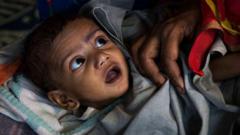India faces a significant child stunting crisis, with astonishing rates surpassing those in Sub-Saharan Africa. New research conducted by Ashwini Deshpande of Ashoka University and Rajesh Ramachandran from Monash University emphasizes that 35.7% of India's 137 million children under five are stunted, in contrast to Sub-Saharan Africa's average of 33.6%. The shocking disparity sheds light on the detrimental role of systemic caste discrimination in perpetuating malnutrition among the nation’s youth.
Child stunting is a critical indicator of nutritional shortcomings, determined by whether a child's height meets age-related expectations. This recent analysis indicates that while both regions exhibit high stunting rates, India’s issues are intricately linked to the social stratification perpetuated by its caste system. The study emphasizes that the initial 1,000 days of a child’s life—often termed the "golden period"—are crucial for brain development and future potential, thus highlighting the importance of proper healthcare, nutrition, and a supportive environment during this time.
Despite shared challenges of poverty faced by both regions—over 85% of the global poor residing in Sub-Saharan Africa and South Asia—the research emphasizes that India’s stunting rates are exacerbated by caste-based disadvantages. The investigation into six distinct socially disadvantaged groups, including adivasis and Dalits, revealed that children from higher caste backgrounds experience significantly lower stunting rates, with stunting in these groups nearly 20% less likely compared to marginalized populations.
While stunting has seen an overall decline in both regions over recent decades, gaps in nutrition persist for individuals from lower caste backgrounds. This ongoing societal inequality undermines positive changes made in healthcare practices and nutrition standards. Researchers posit that a laser focus on genetic or purely nutritional factors is inadequate to unravel the stunting crisis. They argue that societal influences, particularly the role of caste, must be acknowledged and addressed to improve child nutrition comprehensively.
The study utilized data from demographic health surveys, encompassing comprehensive anthropometric measurements of 195,024 Indian children, alongside a comparative analysis of 202,557 children in 19 Sub-Saharan African nations, encompassing both regions' respective public health challenges. This comprehensive dataset reveals that socioeconomic status and maternal education are pivotal in determining vulnerability to stunting, ushering a call for more inclusive policies to address the complexities of child health crises rooted in deep social identities.




















